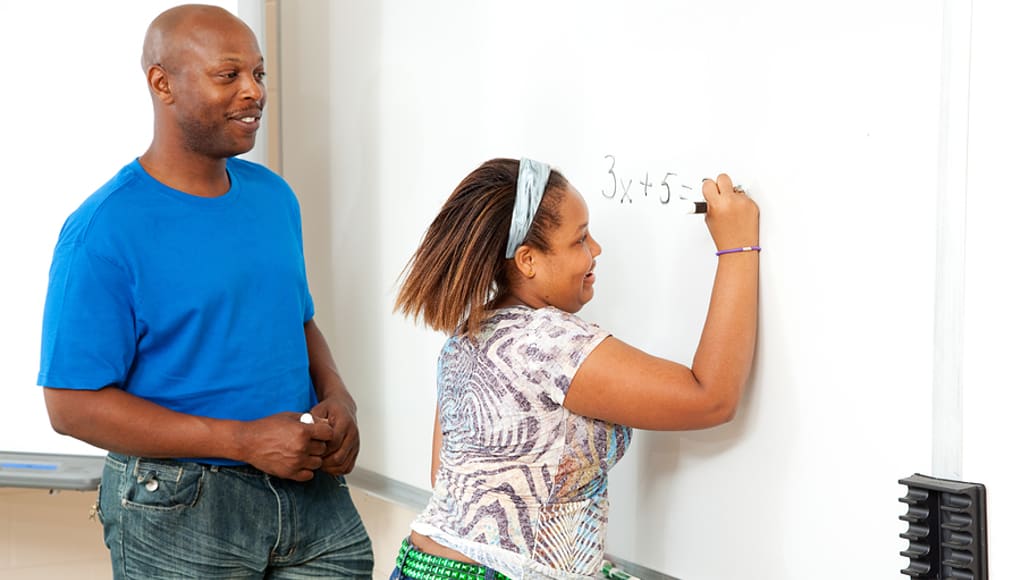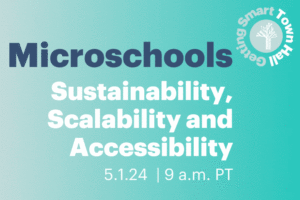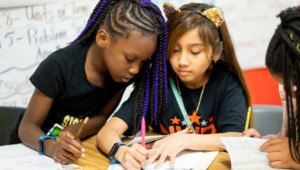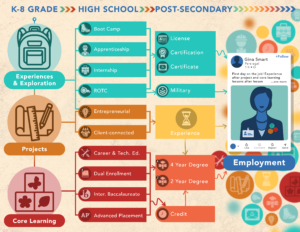Is Personalized Learning the Answer?

By Mark Lang
Education is under serious challenges today, and many believe that personalized learning is the answer. Before everyone jumps in, however, we should examine its ability to address the real problems.
The problem talked about most is students‘ unsatisfactory performance on tests and graduation rates, especially in such measures among less privileged students. These are valid concerns, but they are really just symptoms of deeper problems. If we ask why the scores are low, we find that too many kids are bored and disconnected from school, and too unwilling or unmotivated or distracted from putting in the effort that is needed.
Why? The old compact that if you perform acceptably well on a standard curriculum of subjects, then you will have access to a good job, is no longer true. Frankly, for decades public schools primarily prepared students to follow instructions with various levels of complexity based on the level of education. This is exactly what was needed for locally competitive mass production jobs.
However, today’s economy is characterized by globally interconnected innovation. In this new environment, we must prepare graduates to thrive in jobs and tasks we cannot even predict using knowledge that is yet to be developed. Their success depends not on what answers they know but rather how well they continuously learn and figure out new and ambiguous challenges.
To make matters worse, we are now trying to educate a much more culturally and economically diverse group of students than ever before. These students bring with them a whole host of non-academic fears, traumas, biases, perspectives, mannerisms and deficits our schools were never designed to address, but nonetheless impact learning. These are no fault of the kids, but result from the very different social and economic situations, cultural backgrounds and opportunities for enrichment and support that different kids experience outside school in our wildly inequitable and discriminatory society.
These are really sobering challenges. How does personalized learning match up? I have been studying the various vendor platforms and many examples in the literature. What I see basically captures and organizes the lessons that would have been presented by the classroom teacher and textbook into a computer-mediated form, often including exercises to apply the lesson and tools to assess what is learned. This unquestionably provides value.
Students have the opportunity to advance through the material at their own pace and go over things as much as they like. In many platforms the assessments are competency-based, so students work on a lesson until they achieve the desired mastery. Students might even assess themselves based on rubrics. Further, lessons can be made more interactive and interesting on computers than in textbooks.
This all seems good until we compare against today’s education challenges. Often, students are still going through the same outdated curriculum, just at a different pace. That curriculum is still mostly content-based, with content likely to soon be obsolete or irrelevant. Students are still often taught by being spoon fed steps and answers they later apply, so they gain no experience figuring out ambiguous challenges. Finally, the learning is still artificially divided by subject and couched in an academic form that students will never see in the real world.
Even the advanced Summit Learning/Facebook platform presents familiar-looking lessons organized within traditional courses and followed by application exercises or projects related to their lesson. I am reminded of business guru Peter Drucker’s distinction between “doing things right” and “doing the right things.” Here we are doing things right (e.g. better preparing graduates to follow instructions).
But we are not doing the right thing, which is preparing our graduates for the adaptation and innovation that enables success today. That is why schools following this path to improved test scores and graduation rates are still making very little progress to help more kids advance through higher education and move into the good jobs of today.
Suppose that, instead of just providing personalized pacing, we fully personalized the learning. We abandon the traditional linear curriculum entirely in favor of projects and problems that are meaningful, authentic and interesting to our specific students. Further, we let the students figure out the solutions largely on their own with peers, working in a safe and supportive environment we create.
Students must figure out what is the real issue, examine what they know and don’t know about that issue, seek to learn whatever content and skills are needed, apply trial solutions and most likely go back again and refine what they have done until they achieve an acceptable answer. Students will likely use tools such as online data and tutorials along the way, but at their own initiative.
This would be addressing both of the key education challenges presented earlier. First, students would be engaged while learning to learn and solve ambiguous problems. Second, by making the activities culturally and passionately authentic to the specific students, we would reinforce each student’s identity and allow each to blossom as he or she is naturally talented. Further, students would develop the understanding of themselves, confidence and grit to overcome those challenges life has given them (and that schools can never fully address). Engaged students who believe in themselves cannot be stopped from learning, and behavior issues would largely go away.
Teachers would still need to make sure that students end up learning the skills and content important for their education, formulating and guiding the learning activities and environment around student interests and steering activities across all projects so students must master important skills to complete them. Some students may learn the same reading, writing and math skills, for example, by creating a robot for a particular task, while others learn them by working on a social issue in the community.
Students would likely cover less content than in a traditional program, but content few would remember anyway. More important, they will become more and more skilled at addressing any problem, and the content they figure out will stick with them beyond the term. They will be learning by practicing what they will need to do in their future careers.
This fully personalized, student-directed learning approach I describe is not just theory. I have used it in special programs, and I have visited pioneering schools built heavily upon it (see deeperlearning4all.org and lventure.org). This learning excites and engages kids and leads to academic mastery, independent thinking, self-understanding and confidence. It is also extremely rewarding for teachers when they see happy students blossom and grow. The barrier is the paradigm shift from teacher-led curriculum to student-centered authentic projects that scares many educators and parents alike.
I don’t diminish the challenge, but I suggest that action is a matter of courageous leadership and commitment. There is a social justice question about whether our country is really committed to providing equal opportunity for all. Beyond that, however, there is the practical need that a society cannot thrive in this advanced world without tapping the full talents of more of the population. The challenge for our country is how we get more educators to understand and be comfortable with the paradigm shift needed for education to once again be the tool that can make our country great.
For more, see:
- Starting With the “Why” in Personalized Learning
- Initiative Aims to Catalyze the Personalized Learning Field
- How Can Families and Communities Support Personalized Learning?
Mark Lang is an independent consultant and education activist in Bethlehem, PA.
Stay in-the-know with all things EdTech and innovations in learning by signing up to receive the weekly Smart Update.




0 Comments
Leave a Comment
Your email address will not be published. All fields are required.